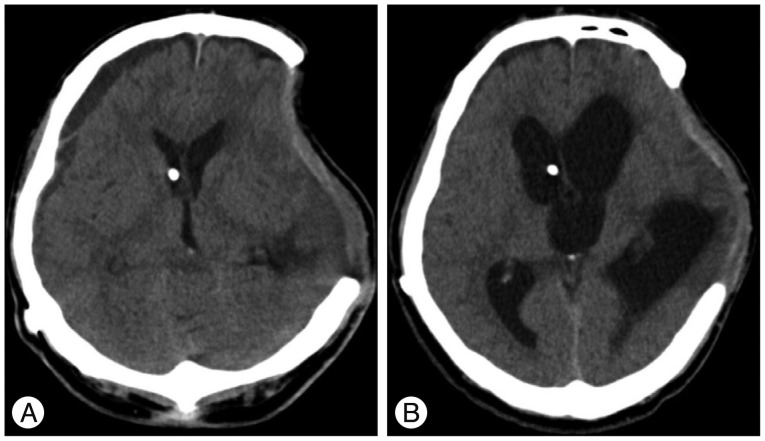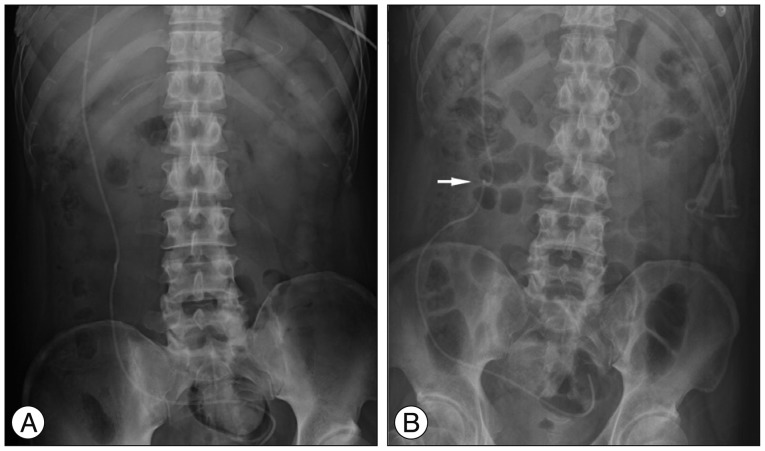J Korean Neurosurg Soc.
2014 Oct;56(4):361-363. 10.3340/jkns.2014.56.4.361.
Acute Shunt Malfunction Caused by Percutaneous Endoscopic Gastrostomy without Shunt Infection
- Affiliations
-
- 1Department of Neurosurgery, Gangwondo Sokcho Medical Center, Sokcho, Korea.
- 2Department of Gastroenterology, Gangwondo Sokcho Medical Center, Sokcho, Korea.
- 3Department of Neurosurgery, Kangwon National University Hospital, Chuncheon, Korea. nsped@kangwon.ac.kr
- KMID: 2018091
- DOI: http://doi.org/10.3340/jkns.2014.56.4.361
Abstract
- Percutaneous endoscopic gastrostomy tube placement is often performed in patients with a ventriculoperitoneal shunt and it has been accepted as a safe procedure. The authors report a case of a 50-year-old male who developed acute exacerbation of the hydrocephalus immediately after the percutaneous endoscopic gastrostomy tube placement without any signs of shunt infection, which has not been reported until now. After revision of the intraperitoneal shunt catheter, the sizes of the intracranial ventricles were normalized.
Keyword
Figure
Reference
-
1. Baird R, Salasidis R. Percutaneous gastrostomy in patients with a ventriculoperitoneal shunt : case series and review. Gastrointest Endosc. 2004; 59:570–574. PMID: 15044902.
Article2. Bannerman E, Pendlebury J, Phillips F, Ghosh S. A cross-sectional and longitudinal study of health-related quality of life after percutaneous gastrostomy. Eur J Gastroenterol Hepatol. 2000; 12:1101–1109. PMID: 11057455.
Article3. Chan Y, Datta NN, Chan KY, Rehman SU, Poon CY, Kwok JC. Extrusion of the peritoneal catheter of a VP shunt system through a gastrostomy wound. Surg Neurol. 2003; 60:68–69. discussion 70. PMID: 12865019.
Article4. Ciocon JO, Silverstone FA, Graver LM, Foley CJ. Tube feedings in elderly patients. Indications, benefits, and complications. Arch Intern Med. 1988; 148:429–433. PMID: 3124777.
Article5. D'Amelio LF, Hammond JS, Spain DA, Sutyak JP. Tracheostomy and percutaneous endoscopic gastrostomy in the management of the head-injured trauma patient. Am Surg. 1994; 60:180–185. PMID: 8116977.6. Graham SM, Flowers JL, Scott TR, Lin F, Rigamonti D. Safety of percutaneous endoscopic gastrostomy in patients with a ventriculoperitoneal shunt. Neurosurgery. 1993; 32:932–934. PMID: 8327094.
Article7. Harbrecht BG, Moraca RJ, Saul M, Courcoulas AP. Percutaneous endoscopic gastrostomy reduces total hospital costs in head-injured patients. Am J Surg. 1998; 176:311–314. PMID: 9817245.
Article8. James A, Kapur K, Hawthorne AB. Long-term outcome of percutaneous endoscopic gastrostomy feeding in patients with dysphagic stroke. Age Ageing. 1998; 27:671–676. PMID: 10408659.
Article9. Jea A, Baskaya MK, Farhat H, Benglis D, Zauner A. Pneumocephalus in a patient with a ventriculoperitoneal shunt after percutaneous gastrojejunostomy catheter placement : case report. Surg Neurol. 2006; 65:87–89. discussion 89. PMID: 16378870.
Article10. Kaw M, Sekas G. Long-term follow-up of consequences of percutaneous endoscopic gastrostomy (PEG) tubes in nursing home patients. Dig Dis Sci. 1994; 39:738–743. PMID: 8149838.
Article11. Kim JS, Park YW, Kim HK, Cho YS, Kim SS, Youn NR, et al. Is percutaneous endoscopic gastrostomy tube placement safe in patients with ventriculoperitoneal shunts? World J Gastroenterol. 2009; 15:3148–3152. PMID: 19575495.
Article12. Nabika S, Oki S, Sumida M, Isobe N, Kanou Y, Watanabe Y. Analysis of risk factors for infection in coplacement of percutaneous endoscopic gastrostomy and ventriculoperitoneal shunt. Neurol Med Chir (Tokyo). 2006; 46:226–229. discussion 229-230. PMID: 16723814.
Article13. Niewiadomski O, Ashrafi A, Stella DL, Hebbard G. Education and Imaging. Gastrointestinal : gastric perforation from long-term ventriculo-peritoneal shunt after insertion of percutaneous endoscopic gastrostomy. J Gastroenterol Hepatol. 2013; 28:204. PMID: 23278156.
Article14. Roeder BE, Said A, Reichelderfer M, Gopal DV. Placement of gastrostomy tubes in patients with ventriculoperitoneal shunts does not result in increased incidence of shunt infection or decreased survival. Dig Dis Sci. 2007; 52:518–522. PMID: 17195119.
Article15. Sane SS, Towbin A, Bergey EA, Kaye RD, Fitz CR, Albright L, et al. Percutaneous gastrostomy tube placement in patients with ventriculoperitoneal shunts. Pediatr Radiol. 1998; 28:521–523. PMID: 9662573.
Article16. Schulman AS, Sawyer RG. The safety of percutaneous endoscopic gastrostomy tube placement in patients with existing ventriculoperitoneal shunts. JPEN J Parenter Enteral Nutr. 2005; 29:442–444. PMID: 16224038.
Article17. Taylor AL, Carroll TA, Jakubowski J, O'Reilly G. Percutaneous endoscopic gastrostomy in patients with ventriculoperitoneal shunts. Br J Surg. 2001; 88:724–727. PMID: 11350449.
Article
- Full Text Links
- Actions
-
Cited
- CITED
-
- Close
- Share
- Similar articles
-
- Malfunction of Ventriculo-Peritoneal Shunt due to Acute Appendicitis
- Ventriculoperitoneal Shunt Malfunction during Pregnancy
- Complications after the Ventriculo-peritoneal Shunt according to the Time Course
- Disappearance of a Distal Shunt Catheter: A Case Report of an Unusual Cause of Shunt Malfunction
- Shunt Function Test Using Radioisotope and ICP Monitoring



